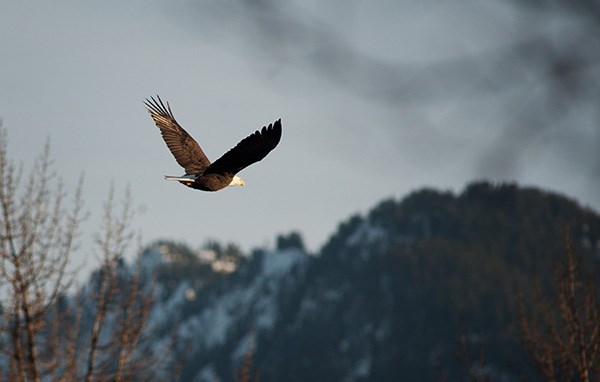Yet another successful winter eagle count is in the books and the dedicated volunteers who do the count each year have recorded one more historically valuable figure.
This was the 29th year that volunteer counters have tromped through forests, paddled canoes through sloughs and hiked along the local dikes to spot eagles on the first Sunday of the year. The database compiled over those 29 years offers an excellent glimpse into the life of the eagle population that settles in between late November to feed on salmon until about early February.
When the first group of counters ventured out in January of 1986, a total of 537 eagles were noted. The next year yielded a count of 952. Then in 1988 the volunteers produced one of the largest counts in the history of the effort. The number of eagles recorded in 1988 was 2,531. That number is well above the average annual count of 1,539 over the course of 28 years. In 1989, the count almost equaled the 28-year average, then in 1990 the count dipped down to 737.
Just in the first five years of the count, the numbers varied by about 2,000 eagles.
Because the count is a one-day snapshot, it isn’t necessarily a great barometer of what happened that season. Counts that happened to have fallen on a day that featured rain and low cloud – or a snowstorm– would produce low numbers despite the fact that just days before thousands of eagles could have been in our area under a bright blue sky with an abundance of food in the Squamish River, the Mamquam River and the tributaries feeding into those two streams.
The stars really aligned in 1994 when 3,769 eagles were found for a record-setting count day. The next year, 1995, also produced a big count; the volunteers spied 2,597 eagles. While that number is impressive, it was a bit of a letdown after the count in 1994.
Between 2007 and 2013 the counts didn't go over 1,000 eagles but the count jumped to 1,617 last year.
Thor Froslev, the host of the count each year, is convinced the salmon farms that dot the B.C. coast have played a major role in dragging the numbers down. He subscribes to biologist Alexandra Morton’s belief that the invasion of foreign-owned, industrial-scale fish farms, populated with Atlantic salmon, has destabilized the B.C. coast.
Putting aside the individual annual results and theories of what has dragged down the eagle count numbers, the data collected each year is very valuable and the volunteers who are quietly contributing this priceless record deserve public recognition for their contribution to science.



